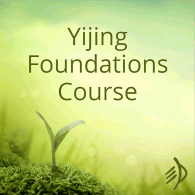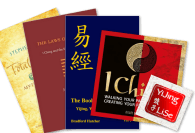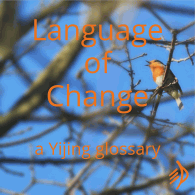Half a thought that came to me when meditating (along with ‘I wonder how long I’ve been sitting for?’ and ‘must buy broccoli’ and all the rest, which are not so much blog post material…)
I’ve embarked on Clare Josa’s excellent 28 day meditation challenge. The guided meditation she recorded for the first week began with roots and branches. You ‘grow’ roots into the earth and branches up, then follow a steady pattern of inhaling through roots, exhaling through branches, inhaling through branches, exhaling through roots. I’ve found I feel the quality of the energy changing, and the opening at the tips of roots and branches: inhaling earth-strength, growing branches, inhaling light, spreading and transmuting into roots…
And then, because my monkey mind is also full of hexagrams, this reminded me of xun
![]()
and dui.
![]()
Xun is the trigram of roots: open and sensitive to what’s below. And the branches mirror that: they’re sky-roots, open above, like dui. So the two trigrams together make a kind of energy diagram of a tree and its relationship to everything around it, open below and above:
![]()
And then isn’t it funny how this hexagram, 28, turns out to be the one that mentions the growth of trees?
28.2:
‘Withered willow sprouts a shoot,
Venerable man gets a young wife.
Nothing that does not bear fruit.’
28.5:
‘Withered willow sprouts flowers,
Venerable woman gets an upright husband.
No blame, no praise.’
And the rejuvenation of the tree even parallels the way humans come back to life through relationship.
And… lines 2 and 5 are each just at the interface between solid and open, where what’s absorbed through the open roots and leaf-surfaces can be felt as part of your self.









Objection !
This guided stuff isn’t actually meditation. Its guided imagery which is not the same thing as meditation. Meditation aims to transcend thought to be in.. pure being…..This stuff which I don’t personally like at all, just keeps you in the realm of thinking about things…other peoples things about trees and whatnot. I alwsys want them to shut up so I can get on with meditating
*grin*
I thought someone might say that. Personally, if it just gets me a little more present and aware, I don’t care in the least what it’s called.
Perhaps a Confucianist term can help: Quiet Sitting. Daoist and Buddhist approaches are different, since they try to get away from the world and ‘transcend’. The Confucianist is in and of this world. In Yi Dao meditation I use the hexagrams to connect with the world, not get away from it. I also do not seek out silence and the typical places for meditating. The best place to do Yi Dao meditation is a crowded cafe or listening to music (real music, not some kind of cloyingly soothing ‘meditation music’). I am just beginning with the technique, and have no substantial instructional material ready, but all you really need to do is meditate on the hexagrams one by one. One path is to try to visualize all 64 at once, either by building the image in your head or seeing it at the end in a moment of realization. Another is to simply concentrate totally on each individual hexagram.
I use a specially designed 64-bead ‘nianzhu’ (mala) to keep track of the hexagram I am on and use a counter to track how many cycles of figures I go through. I’ve just finished two years of prototyping and testing and completed the first 16 units. If I ever finish writing the instructions I’ll make them available on Etsy and Ebay.
This is a picture of one of an Yi Dao circlet (mala): http://campl.us/hJZS
In fact it’s a picture of 17, my personal one and 16 in the box behind it.
They’re beautiful. So… are you visualising the 6-line figures as you go through? And do you always start in the same place, and if so do you wind up building an association between each hexagram and ‘its’ bead?
But don’t spend too much time here… I’d like to see those finished instructions 🙂
28.2 changing to yin – grows shoots. 28.5 changing to yin – grows flowers. Makes a lot of sense!
Hex. 28 has a lot to do with entering a new phase in life, often retirement, the old ridgepole is sagging. But if you can make the openings down or up larger, you can postpone that. New life-energy from the earth, new shoots, a young wife. Or new spititual energy from above, new flowers, a young husband.
Love it!
Al inglés lo leo pero no lo escribo, el traductor tendrá trabajo conmigo.
Un sauce, viejo o joven, renace de sus raíces. Los cortas y vuelven a crecer a menos que saques las raíces. Si cortas una rama de sauce y la entierras se hace un árbol. Pero si debilitado por la edad hace flores, muere.
Han usado esta metáfora para señalar la prudencia y circunspección necesaria para transitar los tiempos del 28.
Meditar con imágenes es lo que hacemos al meditar en los hexagramas del I Ching. Los hexagramas están siempre presentes en nuestro mundo, una de mis hijas es el 28. Tiene que ver con la palabra, las palabras son como las flores del tao. Y es la muerte porque lo que dices no lo puedes cambiar. Está dicho de una vez para siempre. Con las palabras se puede herir, ser incisivo, cortante, afilado, alegre, risueño, encantador. Todos dotes de Tui. Es necesario ser cuidadoso con las palabras, las palabras pueden cambiar drásticamente tu mundo.
Cuando las palabras surgen del corazón de sun son vivificantes, cuando surgen del corazón de tui son determinantes. Con el corazón de sun vamos al 31, con el corazón de tui al 32.
Marta! It’s great to see you here. And as I can neither read nor write Spanish, I will see if someone has a moment to translate your comment.
I only wish someone would translate your whole blog, too. What little I can understand of it from Google Translate looks completely fascinating.
Gracias Hilary, el gusto es mío también.
Aunque sé que hay más cultores del I Ching de lengua inglesa que española y me gusta difundir el uso del I Ching, las traducciones son muy difíciles de lograr.
Consulté con la lectura on-line que has diseñado, me ha servido mucho. Era una consulta muy importante, que venía posponiendo hasta tomar una decisión, ayer tomé la decisión y hoy me llegó tu nota con la novedad de la lectura on-line. La usé sin dudar un segundo. Gracias Hilary
Here’s a translation to Marta’s comment:
English I can read but cannot write, the translator (T.N.: I suppose she means Google and not this humble servant) will have work with me.
A willow, old or young, is reborn from its roots. You cut them down and unless you take the roots away, it will regrow. If you cut a willow branch and you plant it, you will have a tree. But, if weaken by age, it flowers, dies.
This metaphor has been used to point to the prudence and circumspection needed to navigate the times of 28.
To meditate with images is what we do when meditating on the hexagrams of the I Ching. The hexagrams are always present in our world; one of my daughters is H28. It has to do with words; words are like the flowers of the Tao. And is death because an uttered word cannot be retrieved (t.n.: literally is “And is death because what you say cannot be changed”, however, that’s how I interpreted it). It is said once and forever. With words we can hurt, be incisive, cutting, sharp, happy, cheerful, enchanting. All characteristics of Tui. It is necessary to be careful with words; words can drastically change your world. When words emerge from the heart of Sun they vivify; when they emerge from the heart of Tui, they are determined. With the heart of Sun we go to 31, with the heart of Tui we go to 32.
=========
Just for you, Hilary… 😀
Thanks, Hilary. I thought I had things set up to see replies, but now I just discovered your reply and others on the thread, so I guess I didn’t check the box.
Anyway, yes, I start from Qian and Kun every time and run through all 64 gua. And you do indeed develop a tactile association with the beads for a particular gua. There is a ‘tower’ of an old Chinese coin, the yak bone disk and the globe at the top. Those I go through only once, in the morning, and they are Yin/Yang, Four Xiang, Ba Gua (starting from globe down). The meditation is a visualization of each figure. I breath in the lower trigram and out the upper. The only exception is the first pair, with Qian getting three full breath cycles and Kun two.
I’ve just finished the redesign and complete restringing of those first 16 units and a few more. I’m happy with the design now, and have been using my newest set for several weeks, so I’m going to create a total of 64 circlets (two are already shipped out, but they are earlier designs that I may recall to restring). I keep track of the daily texts on my Twitter (zhouyidao) and blog, also recording when I complete a Grand Circlet (8 cycles of 8 complete Yi Dao circlets visualized).
Eighteen pages of the accompanying instructions/teachings so far. I’m going to make a small book of it before publishing and skip paper altogether. I have a friend who may translate it into Chinese for me, which is exciting, since the greatest potential demographic for students of the Yi Jing looking for a path that is at once spiritual and materialist is definitely China, and he chances to have philosophical associations in Shandong, which is ‘Zhouyi Central’ at the moment .
Thank you, Marta! (And Google translate did a great job on your second comment – I’m glad you like the online reading.) So… you’re saying that the flowering is itself a sign of age – a final flowering? And then words are ‘flowers of the tao’ in that sense?
The words from the heart of tui… are they determined, or determining?
I do love how you’re thinking with trigrams here.
Luis, thanks :). I will try to make do with Google translate plus residual echoes of French and Latin…
Chris – yes, I’ve also found it natural to breathe in the lower trigram, breathe out the upper trigram. But only with one hexagram at a time… I might try your approach. I’m certainly looking forward to the ‘small book’. Do you go through the King Wen sequence?
I’m not sure a flowering willow is a dying willow, however, a flowering bamboo is a dying bamboo.
BTW, the willow has a rich folk tradition in ancient China.
Cuando algo está en condiciones de florecer es porque ha llegado a la plenitud. Puede ser un ciclo de vida, puede ser la vida toda.
Las flores del tao son pasajeras, son los entes del mundo, todo lo que hay. Por eso en el taoísmo y el zen se suele decir “elijo el fruto y descarto la flor”. Porque la flor es pasajera y el fruto es descendencia, transformación o transmutación
Cuando algo florece y es viejo su floración es terminal. Por eso es determinante y no puede echar marcha atrás, realmente es el final. No llega a fructificar, no deja descendencia. No tiene energía para el fruto.
Cuando algo muere se detiene en el tiempo. Queda fijado, como una fotografía. Esa es la condición de no cambio, la muerte. Es la inmortalidad, porque ya estás muerto, no puedes volver a morir.
Pero el i Ching considera, a mi ver, una condición de trascendencia a la muerte. Es el fruto. La segunda línea da fruto, la quinta no.
La segunda línea es el estímulo, la presencia estimulante en la memoria de los hombres de ese ser que ya no es pero de algún modo es inmortal. Son Los Inmortales porque su descendencia es interminable, como Lao Tzu. Los de largo aliento, los que emiten su palabra desde Sun, su influjo es poderoso, sus frutos interminables. No importa si su nombre es conocido, lo que importa es la persistencia del Influjo.
El sauce es poderoso e interminable, el viejo hombre sauce puede tener un corazón bueno o malo. Y así son sus frutos, dañinos o amorosos.
Hilary, marta47 es mi avatar de wordpress, no lo había usado porque no advertí que tu blog es de wordpress. Nos estamos conociendo.
Felicidades!
Hilary, yes, the King Wen. It’s the sequence I’ve used in my head all my life, so I’m sticking with it. It would certainly be interesting to experiment with the binary order (Fu Xi), or the Family Trigrams order (Mawangdui).
Here’s a translation of Marta’s more recent comment – contributed by another kind friend!
Thanks to translating friends everywhere 🙂
Es una maravilla esta posibilidad de comunicación! Gracias, a todos!